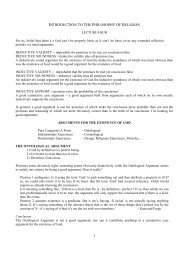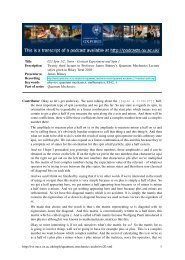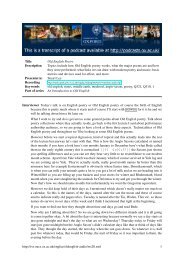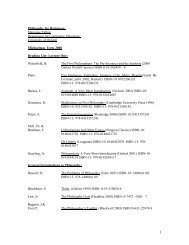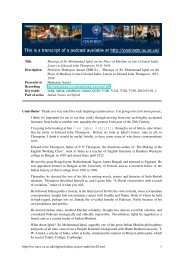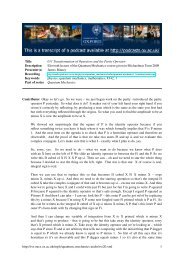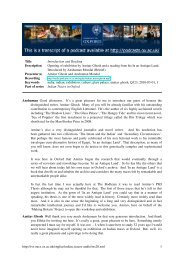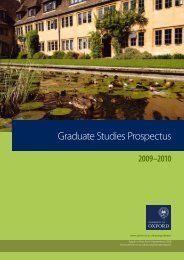The 'Second Demographic Transition' â new forms of family
The 'Second Demographic Transition' â new forms of family
The 'Second Demographic Transition' â new forms of family
Create successful ePaper yourself
Turn your PDF publications into a flip-book with our unique Google optimized e-Paper software.
DEPARTMENT OF SOCIAL POLICY AND SOCIAL WORK<strong>The</strong> ‘Second <strong>Demographic</strong> Transition’ – <strong>new</strong><strong>forms</strong> <strong>of</strong> <strong>family</strong>David ColemanUniversity <strong>of</strong> Oxforddavid.coleman@spi.ox.ac.ukhttp://www.spi.ox.ac.uk/oxpop
Background: the transformation <strong>of</strong> the WestEuropean Marriage SystemMean age at marriage, bachelors and spinsters, England and Wales 1889 - 2001. Source: ONS Series FM23432302826242220bachelorsspinsters18891893189719011905190919131917192119251929193319371941194519491953195719611965196919731977198119851989199319972001
30.029.028.027.026.0Mean age at first marriage, groups <strong>of</strong> Europeancountries 1960 – 2002. Source: EurostatMean Age at First Marriage (females), groups <strong>of</strong> European countries 1960 -2002Scandinavia meanSouthern Europe meanNW Europe meanCEE meanFSU meanformer Yugoslavia mean (ex Bosnia)25.024.023.022.021.01960196219641966196819701972197419761978198019821984198619881990199219941996199820002002
.Marriages – UK 1951 – 2009. source ONS.
Elements <strong>of</strong> the Second <strong>Demographic</strong> Transition(SDT) theory (van de Kaa, Lesthaeghe 1986)Empirical evidence <strong>of</strong> radical innovations in demographic /social behaviour since 1960s:High levels <strong>of</strong> cohabitation, extramarital births, retreat frommarriage, divorce, lowest- low fertility.Associated with spread <strong>of</strong> <strong>new</strong> attitudes and values <strong>of</strong>tolerant, individualistic nature (post-materialism).Inevitable consequence <strong>of</strong> realisation <strong>of</strong> higher-order humanneeds in prosperous, educated, secular, secure welfaresocieties (Maslow, Ingelhart).Will therefore become a universal attribute <strong>of</strong> developedsocieties.
Model <strong>of</strong> first and second demographictransitionsvan de Kaa 2001 (Bad Herrenalb)
A hierarchy <strong>of</strong> human needs. (Abraham Maslow,Motivation and Personality, 1954).
Measuring post-materialism. Ingleharts postmaterialistquestionnaire. Bold = short questionnaire. Blue =materialist responses; green = postmaterialist responsesRobert Inglehart (1977) <strong>The</strong> Silent Revolution: Changing Values and Political Styles among WesternPublics.A Maintain order in the nation.B Give people more say in the decisions <strong>of</strong> the government.C Fight rising prices.D Protect freedom <strong>of</strong> speech.E Maintain a high rate <strong>of</strong> economic growth.F Make sure that this country has strong defence forces.G Give people more say in how things are decided at work and in their community.H Try to make our cities and countryside more beautiful.I Maintain a stable economy.J Fight against crime.K Move towards a friendlier, less impersonal society.L Move towards a society where ideas count more than money.
post materialist attitudes and valuesReligiosity and living arrangements respondents 20-29 inBelgium, France, West Germany and Netherlands 1990MenWomenSingle Cohab Married Single Cohab MarriedwithwithBeliefs (odds ratio) parents parentsBelieves in God 1.0 0.52 1.86 1.0 0.39 1.54Believes in Sin 1.0 0.47 1.48 1.0 0.69 1.35Prays outside church 1.0 0.60 1.07 1.0 0.59 1.85Believes in reincarnation 1.0 3.29 1.03 1.0 0.72 0.35Thinks never justified (%)Both sexesTaking drugs 70 62 85Cheating taxman 31 22 41Avoiding fares 34 30 48Fighting with police 29 29 44Littering 59 62 65Lying 13 18 20Drink-driving 56 67 65Source: Lesthaeghe and Moors 1996
Evidence for the SDT 1:Trends in Total DivorceRate. Source; Eurostat.0.600.500.40Total Divorce Rate, groups <strong>of</strong> European countries 1960 -2000Southern EuropeScandinaviaCEEBalkans (FR Yugoslavia only)Western Europe0.300.200.100.00196019621964196619681970197219741976197819801982198419861988199019921994199619982000
Evidence for the SDT 2: percent ever-married,1935 and 1960 birth cohorts. Source: Eurostat.10090Proportions <strong>of</strong> women ever-married by 2002, selected European countries,Source: Eurostat.1935 birth cohort1960 birth cohort8070605040SwedenSwitzerlandFinlandAustriaDenmarkFranceNorwayBelgiumNetherlandsE&WItaly
Evidence for the SDT 3: Trends in Total FirstMarriage Rate. Source: Council <strong>of</strong> Europe and Eurostat.1.2Total First Marriage Rate, groups <strong>of</strong> European countries 1960 - 2002.Source: Council <strong>of</strong> Europe1.11.00.90.8Scandinavia mean0.7Southern Europe meanNW Europe mean0.6CEE mean0.50.4FSU meanformer Yugoslavia mean (ex Bosnia)1960196219641966196819701972197419761978198019821984198619881990199219941996199820002002
Evidence for the SDT 4: Trends in births outsidemarriage. Sources: Council <strong>of</strong> Europe, Eurostat, National statistical yearbooks600Births outside marriage per 1000 live births, European regions andAnglosphere 1955 - 2010. Source: Council <strong>of</strong> Europe, Eurostat, national demographic yearbooks.500400Scandinavia 4English-speaking world outside EuropeWestern EuropeEastern Europe and FSUSouthern Europe30020010001955195719591961196319651967196919711973197519771979198119831985198719891991199319951997199920012003200520072009
Evidence for the SDT 5: high levels <strong>of</strong> cohabitation.Source: Kiernan 2004 table 2.1009080706050403020100SwedenPartnership status, men and women aged 25 - 34 years, EU countries 2000-2001. Percent, ranked from left by order <strong>of</strong> percent ever-cohabited.Source: Kiernan 2004 table 2.DenmarkFranceFinlandEast GermanyAustriaGreat BritainNetherlandsLuxemburgIrelandWest GermanyBelgiumUnmarried, ever-cohabitedEver marriedSpainGreeceItalyPortugal
Evidence for the SDT 6: association between postmaterialvalues and demographic behaviour. Source:World Values Study
Some problems with the SDT conceptNo so much Second but secondary?Not really <strong>Demographic</strong>?Not (yet) a TransitionStatistically incoherent (in respect <strong>of</strong> fertility).Not the only available model for demographicchange (e.g. central and eastern Europe).Remains a highly influential and testablemodel.
Not Second but Secondary?Certainly a major change in behaviour. But someaspects not without precedent (Cliquet 1991).Other transitions important (e.g 16 th C. WestEuropean Marriage Pattern)In some respects a consequence <strong>of</strong> First<strong>Demographic</strong> Transition or a continuation <strong>of</strong> it.Data for earlier periods almost non-existent
Not <strong>Demographic</strong> – does not address thecentral issues?Demography deals centrally with birth and death,migration and populationSDT concept more concerned with sex, changingmorals and living arrangementsPrediction <strong>of</strong> very low fertility not supported byinternational comparisonsDoes not address mortality or population growth,decline or ageing unless held responsible for verylow fertility.Has nothing directly to say about migration.
Not a Transition?A transition is permanent, universal, irreversible.Otherwise a regional or geographically limited set <strong>of</strong>behaviour.Some take it, some leave it: result is diversity, notuniformity (so far).Nowhere yet universal, unlike FDT.Will other cultures (e.g.) Muslims adopt it?Some elements traditional in non-European societies(simple societies, South America)?However, now emerging over a wider area (Japan).
Variety in preferences for living arrangements1990s.Table 4.3 Preferred living arrangements by country, selected European countries 1994Austria CzechoslovakiaItaly NetherlandsSpain SwitzerlandMarriage 18 64 76 48 75 64Cohabitation then marriage 37 25 11 36 8 19Living apart together 16 4 5 5 2 4Cohabitation, no marriage 8 4 2 7 5 5Living alone 6 1 5 2 6 5Other 15 1 1 1 1 2Sharing flat 1 1 2 2Proportion preferringmarriage55 89 87 84 83 83Note: columns may not sum to 100 because <strong>of</strong> roundingSource: Palomba, R. and H. Moors (1995) Volume II table 4.1(Population Policy Attitudes and Acceptance Survey)
More variety: Spatial distribution <strong>of</strong> the SDT factorfor US Counties (blue=more)Lesthaeghe, Neidert and Surkyn 2006
Imagined countries
Not reversible?1.21.1Total First Marriage Rate, selected countries 1960-20021.00.90.80.70.60.5DenmarkGermanyFranceIcelandSpainUKFinland0.41960196219641966196819701972197419761978198019821984198619881990199219941996199820002002
Birth rates can go up as well as down4.5Total Fertility trends, industrial higher-fertility countries 1945-2010Source: Council <strong>of</strong> Europe, Eurostat and national statistical yearbooksDenmark4.0France3.53.02.5NZUSANorwayUnited Kingdom2.01.51.01945194819511954195719601963196619691972197519781981198419871990199319961999200220052008
Transitions must be sustainable. Is this one?Fiscal burdens e.g. divorce adds 15% to UK benefitbill (£15 bn); creates 3 for 2 <strong>new</strong> households.Can an economy afford SDT and population ageing?<strong>The</strong> latter is unavoidable.Psychosocial externalities. In UK and US at least,some evidence that <strong>new</strong> living arrangementsdamage childrens (social) health and prospects.Long-term consequences on cohorts?
A coherent concept?Illegitimacy Ratio and Total Divorce Rate, selected0.6European countries 2000. Source: Council <strong>of</strong> Europe 20020.5Total Divorce Rate0.40.30.2y = 0.0048x + 0.2232R 2 = 0.38010.10.05 15 25 35 45 55Births outside marriage per 100 live birthsTotal First Marriage Rate0.750.700.650.600.55Total First Marriage Rate by Total Divorce Rate,West European countries, 2000. Source: Council <strong>of</strong> Europe 2002y = -0.1848x + 0.6718R 2 = 0.10470.500.1 0.2 0.3 0.4 0.5 0.6Total Divorce Rate
An incoherent concept? International comparisonsshow that populations most enthusiastic for SDThave the highest fertility.700TFR and Births outside marriage 2000Iceland600Sw eden500400BulgariaUKNorw ayDenmarkFranceFinlandIllegitimacy RatioAustria300Germany200 SpainItaly100Greece01.21.4PortugalSw itz1.6NetherlaLuxembur1.8Ireland2.02.2Total Fertility Rate
Reversal <strong>of</strong> the international correlation betweenwomens workforce participation between 1970 and1990.YEAR: 1970YEAR: 19944.0IRE2.2ICEUSAtotal fertility rate3.53.02.52.020ESPPORNLGRE ITA30LUXNORCANBEL1.5 Rsq = 0.316940ICEFRA USA UKAUTSWIFRG50DEN SWEFIN60percentage <strong>of</strong> females aged 15-64 in employment70total fertility rate2.01.81.61.4SWEIRENORFINCAN DENUKLUXFRANLBELAUT PORGREFRGITAESP1.2 Rsq = 0.516540 50 60 70 80 90perc entage <strong>of</strong> f em ales aged 15-64 in employ ment
underlying theorySDT good as empirical description <strong>of</strong> behaviourInglehart post-materialism an uncertain theoreticalfoundation : really different fromconservativism / liberalism? Weak test / retestand predictive power?Plurality <strong>of</strong> explanations needed for diversesituations (CEE).Ultimately an Economic model?
Is CEE really post-materialist?600500Births outside marriage per 1000, 1970-2001, CEE40030020010001970197219741976197819801982198419861988199019921994199619982000Belarus Bulgaria Czech RepublicDDR Estonia 3*Real GDP/NMP in Eastern Europe3*Real GDP/NMP Baltic States 3Real GDP/NMP CIS
Central and Eastern Europe demographic behaviourSecond demographic transition?Post – communist modernisation and the end<strong>of</strong> Hajnals line?Social dislocation and anomie?
Rapid modernisation <strong>of</strong> marriage in Central andEastern Europe post-19891.2. Total First Marriage Rate, selected countries 1960-20021.11.00.90.8Denmark0.7FranceIceland0.6UK0.5FinlandBulgaria0.4Czech Republic f1960196219641966196819701972197419761978198019821984198619881990199219941996199820002002
450400350300250200Post-communist transitions in Central and Eastern Europe.Trends in births inside and outside marriage indexed to 100 in1960. Source: Eurostat and Council <strong>of</strong> Europe.Births inside and outside marriage 1960 - 2001, selected CEE countries, 1960 number set at 100Bulgaria maritalBulgaria non-maritalHungary maritalHungary non-maritalRomania maritalRomania non-marital150100500196019621964196619681970197219741976197819801982198419861988199019921994199619982000
Mixed messages from East AsiaMean age at first marriage, females, East Asia 1947 - 2003.Sources: National Statistical Offices, Pr<strong>of</strong>. Doo-Sub Kim29282726Taiwan meanKorea SMAMJapan mean2524232221201919471949195119531955195719591961196319651967196919711973197519771979198119831985198719891991199319951997199920012003
Mixed messages from East Asia 2Table 1. Proportions <strong>of</strong> women never-married by ages 30-34 and 40-44, selectedEast Asian countries, and Bangkok.30-34 1950 1960 1970 1980 1990 2000Peninsular Malaysia (Chinese) 3.8 9.5 13.3 15.8 18.2Taiwan 2.1 6.6 11.4 11.1Japan 5.7 9.4 7.2 9.1 13.9 26.6Korea 0.5 1.4 2.7 5.3 10.7Singapore (Chinese) 4.7 11.1 17.8 22.4 21.9Hong Kong 6.0 5.6 11.0 24.8 26.5Bangkok 11.9 17.3 25.1 29.4 32.840-44Peninsular Malaysia-Chinese 2.6 3.4 5.8 6.4 8.4Taiwan 1.3 4.6 2.2 3.6Japan 2.0 3.2 5.3 4.4 5.8 8.6Korea 0.1 0.2 0.5 1.1 2.6Singapore (Chinese) 5.2 3.8 6.7 12.3 14.1Hong Kong 5.9 2.9 2.7 7.3 9.0Bangkok 5.3 7.5 10.7 15.6 19.9Source: Jones 2003 Table 1; Population Statistics <strong>of</strong> Japan 2003 table 6.22.Notes: Blank = no data. Hong Kong '2000' data are for 1996.
Mixed messages from East Asia 3Table 2. Marriage and divorce trends Korea and Japan 1930 - 2000JapanKoreamarriage divorces divorces/ marriage divorces divorces/100marriages100marriages1930 506674 51259 10.1 180833 8894 4.91940 666575 48556 7.3 158271 8151 5.21950 715081 83689 11.7 85043 3223 3.81960 866115 69410 8.0 186187 7016 3.81970 1029405 95937 9.3 295137 11615 3.91980 774706 141689 18.3 403031 23662 5.91990 722138 157608 21.8 399312 45694 11.42000 798138 285911 35.8 334303 119982 35.9Note: Korea '1940' data are for 1938, '1950' data are for 1949.Sources: Population Statistics <strong>of</strong> Japan 2003 tables 6.1, 6.2, Kim2004 Table 6.1
Mixed messages from East Asia 4140120100Births outside marriage per 1000 live births, Japan, South Korea, Hong Kongand Taiwan 1947 - 2010. Sources: national statistical <strong>of</strong>fices.Hong KongTaiwanJapanSouth Korea8060402001947195019531956195919621965196819711974197719801983198619891992199519982001200420072010
ConclusionsMany aspects <strong>of</strong> West European system gone, othersremain and becoming universal.SDT a creative, valuable, testable, influential idea.SDT behaviour incomplete and limited so far.Has little connection with lowest-low fertility.May be acceleration and diffusion <strong>of</strong> behaviour withdeep roots.Only a partial transition for Europe, uncertainsustainability, 3 rd world future problematic.P-M is only one <strong>of</strong> several possible theoreticalmodels for empirically similar behaviour in CEE.



